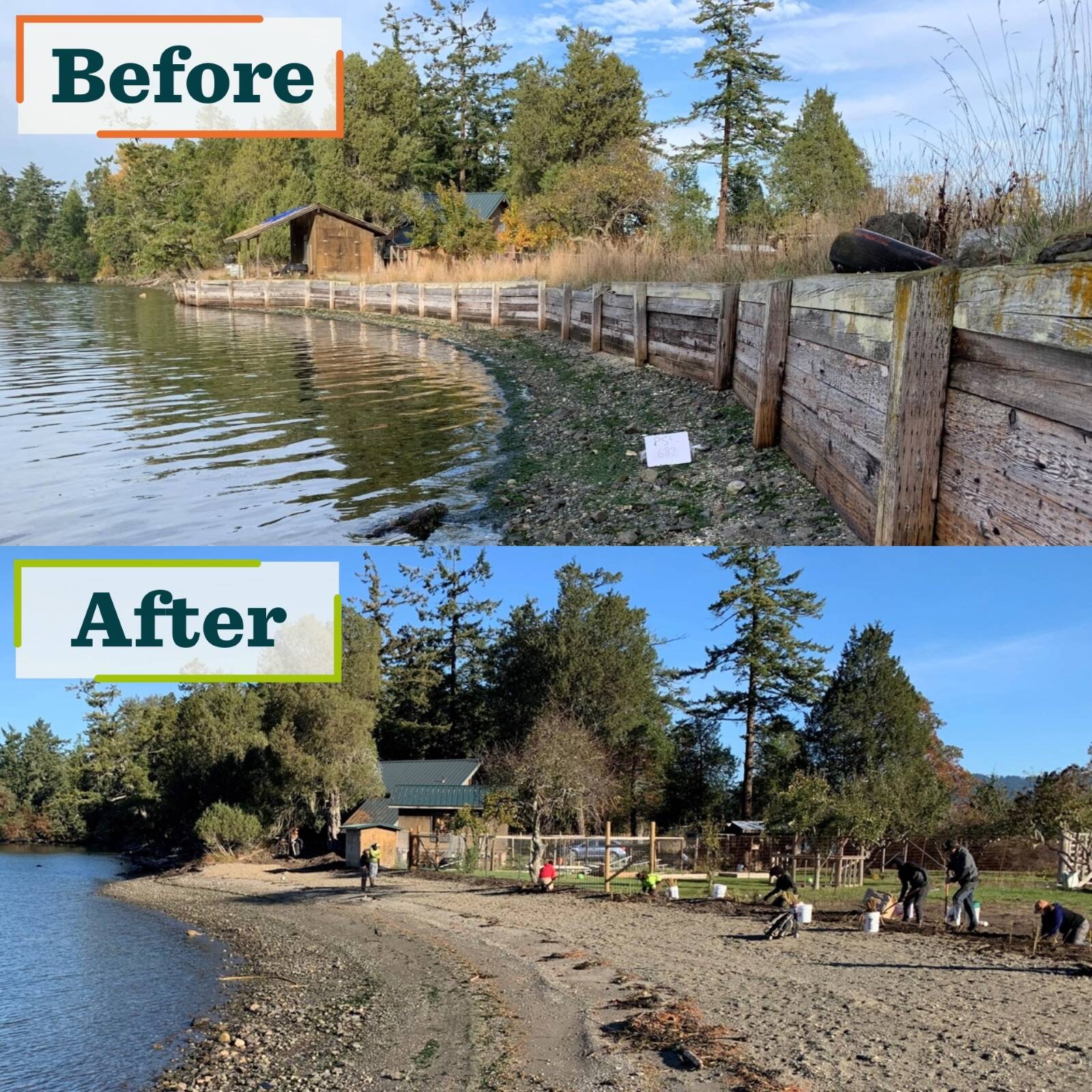Submitted by Friends of the San Juans
In a remarkable effort to return a beach to its natural state, a comprehensive restoration project was successfully completed this past month on Shaw Island. Situated on the western edge of Broken Point, this revitalized beach is re-joining a vast network of healthy shorelines that support forage fish, salmon, and ultimately, the Southern Resident Killer Whales.
The Broken Point Restoration Project, spearheaded by Friends of the San Juans and a private landowner, involved the full removal and proper disposal of a 225-foot-long creosote wood retaining wall along with more than 50 dump truckloads of unnatural rock and dirt fill. Creosote is toxic and harmful to people, fish, and wildlife. With the help of the Islands’ Conservation Corps, 1,500 dune grass plants and over 50 native shrubs were planted as a natural erosion buffer and habitat. As part of the project to improve resiliency at the residential shoreline site, an outbuilding and garden fence was moved back, away from marine waters.
The Broken Point restoration project first came to fruition when the waterfront property owner, Corinne Storey, contacted Friends of the San Juans with concerns about her beach. After the successful completion of the project, the property owner said, “Friends of the San Juans is such a dedicated team, passionate about preserving the region’s natural splendor. They successfully removed the deteriorating bulkhead wall, which previously obstructed beach access. Now a naturally sloped beach runs the length of my property. Friends of the San Juans held my hand every step of the way and answered my continuous questions and concerns. Words cannot express my gratitude and appreciation for the support they showed through this long project.”
Local contractor, Shaw Island Excavation, was hired to implement the beach restoration project, guided by engineering coastal geologists from Natural Systems Design and archeologists from Caldera Archeology. Funding for the project came from the Washington State Salmon Recovery Funding Board and Estuary and Salmon Restoration Program, the private landowner, and Friends supporters.
Katherine Dietzman, Science and Education Coordinator at Friends of the San Juans, who helped manage the project shared, “With over 400 miles of marine shoreline, the San Juans are critical for the vitality of our shared marine food web that supports present and historical Tribal cultures and lifeways, as well as our local island communities. The opportunity to remove this toxic structure and restore a beach was a big win for people and nature.”
In the San Juan Islands, over 90% of waterfront tax parcels are in private, residential ownership. That means that a crucial aspect of shoreline protection involves empowering residents to be stewards of their environment. Friends of the San Juans offers free technical assistance, providing waterfront property owners the opportunity to meet with highly qualified and experienced engineering coastal geologists and shoreline biologists.
Site visits with technical experts are available for those with a structure (such as the one just removed at Broken Point) or without. These free consultations cover various aspects, including conditions, geology, erosion, flooding, vegetation, habitat, and more. Friends of the San Juans has completed site visits with more than 450 waterfront property owners since 2008, resulting in numerous positive actions taken to protect and restore shoreline habitats for people and nature.
In the past 15 years, Friends of the San Juans has led close to 20 shoreline habitat restoration projects in collaboration with private, public, and Tribal landowners; and is on track to restore beach habitat at four additional sites in San Juan County by 2025. These habitat projects would not be possible without the collaborative support of islanders, donors, volunteers, and members of Friends of the San Juans. For more information about Friends of the San Juans and ways that you can protect and restore the environment, please visit sanjuans.org.




